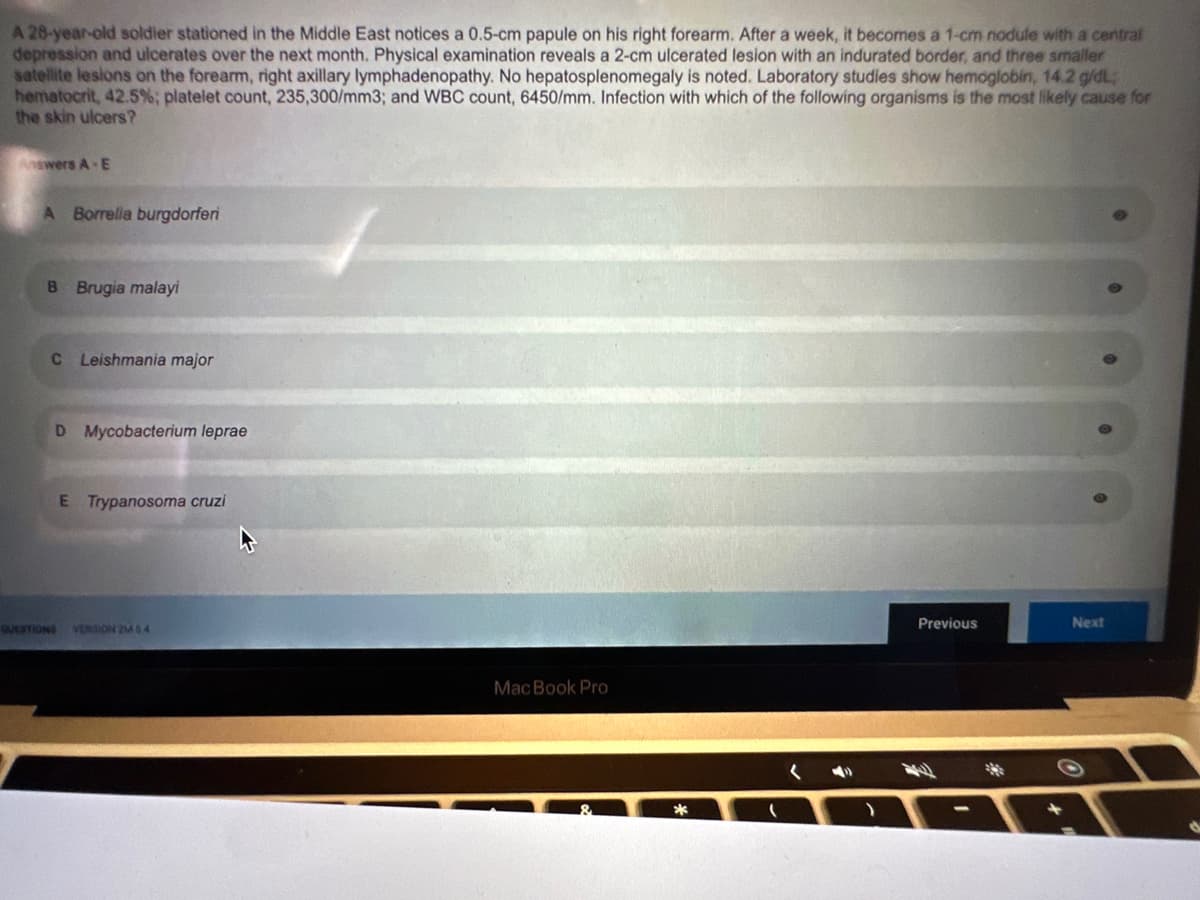A 28-year-old soldier stationed in the Middle East notices a 0.5-cm papule on his right forearm. After a week, it becomes a 1-cm nodule with a central depression and ulcerates over the next month. Physical examination reveals a 2-cm ulcerated lesion with an indurated border, and three smaller satellite lesions on the forearm, right axillary lymphadenopathy. No hepatosplenomegaly is noted. Laboratory studies show hemoglobin, 14.2 g/dL; hematocrit, 42.5%; platelet count, 235,300/mm3; and WBC count, 6450/mm. Infection with which of the following organisms is the most likely cause for the skin ulcers? Answers A E A Borrelia burgdorferi B Brugia malayi C Leishmania major D Mycobacterium leprae E Trypanosoma cruzi
A 28-year-old soldier stationed in the Middle East notices a 0.5-cm papule on his right forearm. After a week, it becomes a 1-cm nodule with a central depression and ulcerates over the next month. Physical examination reveals a 2-cm ulcerated lesion with an indurated border, and three smaller satellite lesions on the forearm, right axillary lymphadenopathy. No hepatosplenomegaly is noted. Laboratory studies show hemoglobin, 14.2 g/dL; hematocrit, 42.5%; platelet count, 235,300/mm3; and WBC count, 6450/mm. Infection with which of the following organisms is the most likely cause for the skin ulcers? Answers A E A Borrelia burgdorferi B Brugia malayi C Leishmania major D Mycobacterium leprae E Trypanosoma cruzi
Chapter14: Allergy: An Overview
Section: Chapter Questions
Problem 19RQ
Related questions
Question

Transcribed Image Text:A 28-year-old soldier stationed in the Middle East notices a 0.5-cm papule on his right forearm. After a week, it becomes a 1-cm nodule with a central
depression and ulcerates over the next month. Physical examination reveals a 2-cm ulcerated lesion with an indurated border, and three smaller
satellite lesions on the forearm, right axillary lymphadenopathy. No hepatosplenomegaly is noted. Laboratory studies show hemoglobin, 14.2 g/dL;
hematocrit, 42.5%; platelet count, 235,300/mm3; and WBC count, 6450/mm. Infection with which of the following organisms is the most likely cause for
the skin ulcers?
Answers A-E
A Borrelia burgdorferi
B Brugia malayi
C Leishmania major
D Mycobacterium leprae
E Trypanosoma cruzi
QUESTIONS VERSION 2M 64
MacBook Pro
Previous
Next
Expert Solution
This question has been solved!
Explore an expertly crafted, step-by-step solution for a thorough understanding of key concepts.
Step by step
Solved in 2 steps

Knowledge Booster
Learn more about
Need a deep-dive on the concept behind this application? Look no further. Learn more about this topic, biology and related others by exploring similar questions and additional content below.Recommended textbooks for you


Health Safety And Nutrition F/Young Child
Health & Nutrition
ISBN:
9781305144767
Author:
MAROTZ
Publisher:
Cengage

Medical Terminology for Health Professions, Spira…
Health & Nutrition
ISBN:
9781305634350
Author:
Ann Ehrlich, Carol L. Schroeder, Laura Ehrlich, Katrina A. Schroeder
Publisher:
Cengage Learning


Health Safety And Nutrition F/Young Child
Health & Nutrition
ISBN:
9781305144767
Author:
MAROTZ
Publisher:
Cengage

Medical Terminology for Health Professions, Spira…
Health & Nutrition
ISBN:
9781305634350
Author:
Ann Ehrlich, Carol L. Schroeder, Laura Ehrlich, Katrina A. Schroeder
Publisher:
Cengage Learning
